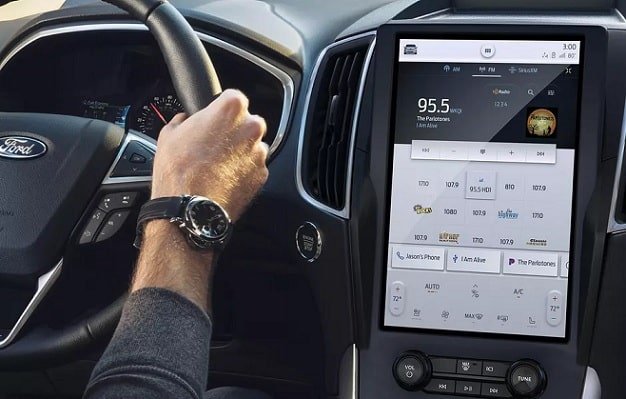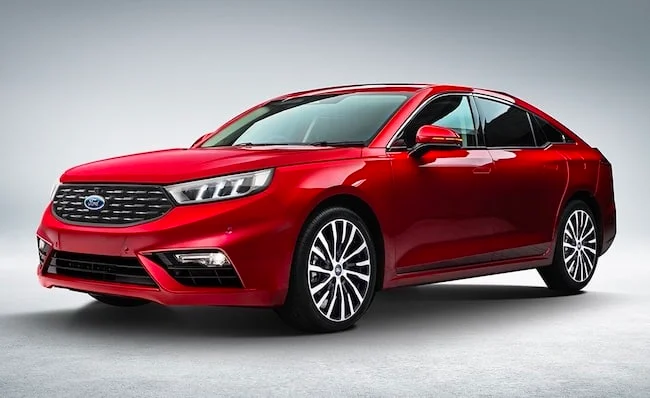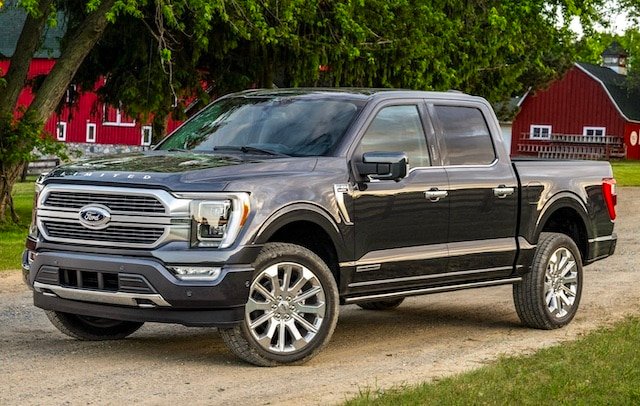The Ford Motor Company has a series of transmissions. Among these transmissions, the C-series are unique and serve as the gold standard for Ford vehicles. Identifying this series can be done visually or by knowing their year of production.
If you are interested in knowing the type of transmission in your Ford vehicle and its interchange options, read this guide until the end.

- Ford Transmission Interchange Chart
- Types of Ford Transmissions
- 1. Conventional Automatic
- 2. 7-Speed Dual-Clutch Transmission
- 3. Powershift Transmission
- Where Do I Find My Ford Transmission Code?
- Ford’s C4 Transmission
- Pros and Cons of The C4 Transmission
- C4 Transmission Performance Specifications
- How Do I Identify A C4 Transmission?
- Conclusion
Ford Transmission Interchange Chart
To save you the stress, we have compiled a list of all available Ford transmissions and their matching vehicles in the chart below:
| Transmission Types | Matching Vehicles |
| 4EAT-F | 1991-95 Ford Escort |
| 4EAT-G | 1989-93 Ford Pro BE 2 2L L4 –3 0L V6
1994-97 Ford Pro BE 2 5L V6 |
| 4R44E | 1995 > Ford Ran GER |
| 4R44E, 4R55E | 1995-98 Ford Explorer |
| 4R55E | 1995 > Ford Rang ER |
| 4R70W | 1995 > Ford Crown Victoria
1994 > Ford F150 1994 > Ford 250 1993 > Ford F350 1995 > Ford Thunderbird |
| 5R55E | 1997 > Ford Ranger |
| A4LD | 1985-94 Ford Aerostar
1984-90 Ford Bronco II 1991-94 Ford Explorer 1985-94 Ford Ranger |
| AOD | 1985-93 Ford Bronco
1983-92 Ford Crown Victoria 1993-94 Ford Crown Victoria 1981-83 Ford F100 1985-93 Ford F250 1980-86 Ford Ltd 1980-83 Ford Mustang/Mustang II 1994-95 Ford Mustang/Mustang II 1980-82 Ford Thunderbird 1993-95 Ford Thunderbird 1983-90 Ford Van |
| AODE | 1993-94 Ford Crown Victoria
1994-95 Ford Mustang/Mustang II 1993-95 Ford Thunderbird |
| ATX | 1981-90 Ford Escort
1982-88 Ford Exp 1985-90 Ford Taurus 1984-94 Ford Tempo |
| AX4N | 1995-98 Ford Taurus |
| AX4S | 1993-96 Ford Taurus
1994-96 Ford Windstar |
| AXOD | 1986-92 Ford Taurus
1993 Ford Taurus |
| AXODE | 1993 Ford Taurus |
| BW35 | 1968-73 Ford Cortina
1972-75 Ford Courier 1967-74 Ford Escort |
| C3 | 1975-81 Ford 2000E
1974-87 Ford Cortina 1978-93 Ford Fairmont 1981-82 Ford Granada 1975-86 Ford Mustang/Mustang II 1974-80 Ford Pinto 1983-84 Ford Ranger 1980-81 Ford Thunderbird |
| C4 | 1974 Ford 2000E
1973-77 Ford Bronco 1974 Ford Cortina 1965-72 Ford F100 1964-72 Ford F250 1964-70 Ford Fairlane 1978-81 Ford Fairmont 1965-71 Ford Falcon 1975-80 Ford Granada 1981-82 Ford Granada 1975-80 Ford Ltd 1977-79 Ford Ltd II 1970-77 Ford Maverick 1966-81 Ford Mustang/Mustang II 1971-80 Ford Pinto 1965-79 Ford Ranchero 1966-81 Ford Thunderbird 1968-76 Ford Torino 1964-77 Ford Ltd |
| C5 | 1982-86 Ford Aerostar
1984 Ford Bronco II 1982-83 Ford F100 1982-86 Ford F150 1982-83 Ford Fairmont 1982 Ford Granada 1982-86 Ford Mustang/Mustang II 1982-86 Ford Ranger 1982-86 Ford Thunderbird |
| C6 | 1978-91 Ford Bronco
1973-83 Ford F100 1975-91 Ford F150 1968-98 Ford F250 1968-98 Ford F350 1992 > Ford F450 1970-78 Ford F500/600 1966-70 Ford Fairmont 1971 Ford Falcon 1975-80 Ford Ltd 1977-79 Ford Ranger 1968-79 Ford Thunderbird 1968-76 Ford Torino 1975-98 Ford Van |
| CD4E | 1995 > Ford Contour
1994-97 Ford Probe 2 0L L4 |
| Cruiseomatic | 1956-60 Ford Thunderbird |
| E4OD | 1994-98 Ford Bronco
1997-98 Ford Expedition 1992-98 Ford F150 1990-98 Ford F250 1989-98 Ford F350 1989-98 Ford F450 1989-98 Ford Van |
| F3A | 1994-97 Ford Aspire (1.6L L4 Engine)
1989-93 Ford Festiva |
| FMX | 1965-72 Ford F350
1971 Ford Falcon 1975-81 Ford Ltd 1977-79 Ford Ltd II 1969-73 Ford Mustang/Mustang II 1968-79 Ford Ranchero 1975-79 Ford Thunderbird 1969-76 Ford Torino |
| L3N718 | 1973-82 Ford Courier |
| MX | 1965-72 Ford F350
1971 Ford Falcon 1975-81 Ford Ltd 1977-79 Ford Ltd II 1969-73 Ford Mustang/Mustang II 1968-79 Ford Ranchero 1961-66 Ford Thunderbird 1975-79 Ford Thunderbird 1969-76 Ford Torino |
Types of Ford Transmissions
Ford cars with automatic transmission usually come in one of these 3 forms:
1. Conventional Automatic
A conventional automatic transmission is operated hydraulically and functions based on planetary gears and a torque converter. In other words, this system is powered by a hydraulic fluid (under pressure).
The fluid is responsible for the coupling and decoupling of gears and controls the engagement and disengagement of the clutch. As your car accelerates, hydraulic pressure changes, forcing the transmission to move in an upward direction within the gear system. When it slows down, downward movement is expected.
2. 7-Speed Dual-Clutch Transmission
The 7-speed dual-clutch automatic transmission consists of two clutches. This gives room for the partial engagement of two gears at the same time and ensures power circulates evenly throughout a shift.
One clutch controls the even gears while the other controls the odd gears. Power control between these two gears is adequately regulated during a gear change. This type of transmission comes with unique benefits like:
- Extremely fast gear changes and enhanced performance
- Better fuel efficiency
- Enhanced adaptability and responsive user experience
3. Powershift Transmission
This is an advanced gearbox that uses a dual-clutch system. The Powershift transmission anticipates and pre-selects the next gear for drivers to avoid losing power when they switch gears.
The first clutch is responsible for gear 1, 3, and 5 while the second clutch controls gear 2, 4, and 6. This means that when the first gear is active, the second clutch is disengaged (only the cogs are active).
When you shift into the second gear, the first clutch becomes disengaged. Only the second clutch and the gear cogs of the third gear are engaged.
Where Do I Find My Ford Transmission Code?
For current owners, your transmission code can be found on the window sticker. Check the vehicle description on top of the window sticker, you should find all the information you need about your car’s transmission there.
For new or intending customers, a series of steps are required:
- Visit Ford’s official website
- Tap on the “vehicle” icon to select a vehicle
- Choose “models” and “specifications” on the page that appears
- Scroll down to the “engine specification” section and select “transmission type” to access the available transmission types for your vehicle.
Ford’s C4 Transmission
The C4 automatic transmission is one of (if not) Ford’s most popular transmission. It marked the turning point for subsequent transmissions. 6 out of 10 Ford vehicles have this transmission, hence, there is a need to know more about it.
Manufactured in 1964, the C4 transmission (aka the 3-speed Cruise-O-Matic transmission) took the reins from the 2-speed Ford-O-Matic transmission. In its first year, the transmission was introduced to Ford Cars such as the Mercury Comet and Fairlane.
Seeing how well the transmission upgrade blended with Fairlane and Mercury Comet, it was introduced to the Ford F-series and Bronco in the second year. Other Ford vehicles with this transmission include the Mustang and Torino.
The longest run of this transmission was in the Ford F-series applications. Trucks manufactured between 1965 and 1983 have the C4 transmission. The F150 inclusive marked the end of the lightweight transmission.
Pros and Cons of The C4 Transmission
The C4 transmission was renowned for different reasons. On the bright side, the transmission is very lightweight and boasts of simple design, longevity, and rapid transmission.
On the other hand, it has minor problems such as difficulty in switching gears (especially from the 1st gear to the 2nd gear) and troubles going into a reverse state. Aside from these two, easily traceable issues, the automatic transmission brought a new era to both Ford cars and truck
C4 Transmission Performance Specifications
In terms of performance, the C4 brought fame to Ford Motors. The automatic transmission is a very popular racing application thanks to its reduced weight.
In addition, the C4 transmission can easily be tweaked and allowed to handle more than 1000 horsepower. This can be done by pairing it with the Windsor 302 (rated at a torque of 333 lb-ft). Please note that only experts are allowed to modify the C4 transmission.
When installing the C4 automatic transmission, it must be mounted longitudinally. The transmission makes use of gear ratios of 2.46 (1st), 1.46 (2nd), 1 (3rd), and 2.18 (for reverse).
How Do I Identify A C4 Transmission?
As you already know, the C4 is designed to be significantly lighter and more durable than the 2-speed Ford-O-Matic transmission it replaced. This is because the C4 is chiefly composed of aluminum alloy as opposed to cast iron in its predecessor.
The electronic transmission can be broken down into 3 major segments – the bell housing, tail housing, and the main case. All three are made of aluminum alloy and weigh just about 110 pounds without a torque converter.
Its predecessor weighs about 228 pounds regardless of the case fill or pan fill condition selected. The C4 transmission takes less than 5.5 quarts of transmission fluid with a torque converter applied.
Conclusion
The C4 transmission remains a major improvement and revelation for the Ford industry. Unlike the Ford-O-Matic, it is durable, lightweight, and is a case study for every new transmission development.
This transmission guarantees a production life of 19 years and 18 years in the F-150. Up to this day, the transmission’s aftermarket value is remarkable and we are sure you have everything you need to decide on the best transmission for your Ford.







